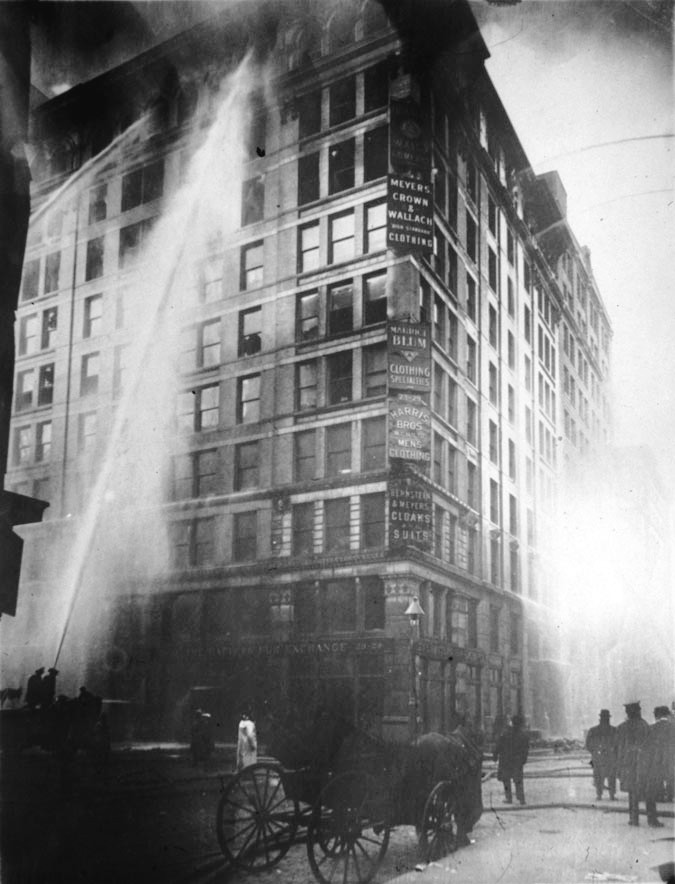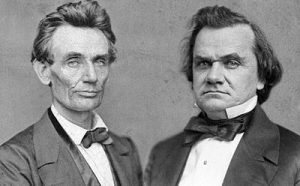It was March 25, 1911, in New York City. It was a Saturday afternoon just like any other at the Triangle Shirtwaist factory, where young immigrant women sat in front of sewing machines, day in and day out, sewing. But on that day a fire broke out, causing the deaths of 146 garment workers. Among those who died in the flames and smoke were 123 women and 23 men.1 Many even jumped or fell to their deaths out the windows, making this event a man-made disaster and one of the deadliest industrial disasters of all time.

The factory was located in the Asch Building at Washington Place in Greenwich Village, one of the wealthiest neighborhoods in the city. The factory occupied the eighth, ninth, and tenth floors of the ten-story building. Max Blanck and Issac Harris were the owners of the factory, and their company was known as the largest firm in the business at the time. They styled women’s blouses known as “Shirtwaists,” which were paired with tailored skirts. This attire had become the standard in fashion for women in the early twentieth century. They were also known to resemble men’s shirts. When it came to their workers, they had hired operators who then contracted out for factory workers. The company itself only dealt with the contractors, and there was no fixed rate of pay for the workers.2 At the time, the factory employed about five-hundred employees, mostly young immigrant women who were of Italian or Jewish descent. These women worked up to eleven-hour shifts on weekdays, and twelve-hour shifts on Saturdays, and they earned between $7-$12 dollars for a 52-hour week. Many of these women were the breadwinners of their household, and their income was sometimes not sufficient to cover their needs.
Towards the end of the workday on that Saturday evening in 1911, a fire broke out around 4:00 pm. The fire started in a scrap bin under one of the cutter’s tables on the eighth floor from what is believed to have come from a cigarette. A manager tried to put the fire out with a hose but the hoses valve was rusted shut, and rotten away. The fire spread quickly and the workers panicked. There was one fire escape that quickly collapsed, and four elevators, which out of the four only one was working. The elevator held twelve people at a time, and it managed to make four rescue trips before it broke down.3 With no other alternatives available, people began throwing themselves out the windows, and some were even crushed to death trying to get out. Workers tried to take the stairs, but the exit doors only opened inward and were kept locked by factory management to prevent theft by the workers, as the managers would check their workers belongings every day before they left for the day.

Celia Saltz Pollack, a survivor of the 1911 Triangle Shirtwaist Fire said,
I remember on that day there was a lot of singing and happiness in the shop because it was the end of the week and we got paid. We were soon all going to go home. When the fire started I was sitting at my machine. I looked up and saw the fire near the cutting tables but I did not think it was so terrible. What was terrible was that the fire spread in a split second.
By the time the firefighters arrived, they came to the realization that their ladders could only extend up to the sixth or seventh floors. With no other option, sixty-two workers jumped and fell to their deaths, while the remaining died from the smoke and flames within the building.4

This fire not only pushed issues of unsafe factories and immigrant exploitation into the public consciousness, but for the first time the fire allowed for attention to be brought to deplorable conditions of New York factories.5 Women obtained well deserved attention onto current work conditions and safety measures in the workplace. Although the Triangle Shirtwaist Factory fire brought a feeling of resentment and heartbreak to many, this event and its victims will always be remembered.
- Ric Burns, “Triangle Shirtwaist Fire,” New York Times (1923-Current File), Nov 24, 1999. ↵
- Jonathan Fink, “Conflagration and Wage: The Triangle Shirtwaist Factory Fire, 1911,” TriQuarterly, no, (2009): 135-136. ↵
- Gale Encyclopedia of U.S. Economic History, s.v. “Triangle Shirtwaist Fire,” by Thomas Carson and Mary Bonk. ↵
- Mia Lynn Mercurio, Régine Randall, “Tributes Beyond Words: Art Educators’ Use of Textiles to Memorialize the Triangle Shirtwaist Factory Fire.” Journal for Learning through the Arts no. 1 (2016): 4-5. ↵
- Albert Marrin, Flesh and blood so cheap: The Triangle fire and its legacy (New York: Alfred A. Knopf, 2011), 23-25. ↵



135 comments
Alexandra Ballard
It’s sad that something horrible has to happen for people to realize something needs to change. Immigrants and women have always been exploited, and many still are. I don’t think it’s fair for these vulnerable groups to be preyed on for cheap labor. I know that wasn’t the main point of the article but I still found it quite interesting. I am glad this catastrophe led to the development of fire departments instead of the issue being brushed over. Great article!
Nathaniel Liveris
Important look into the development of fire safety! From the buildup to how the fire started to its end, I found the most unfortunate part of the story was the inability of the fire fighters to reach the women above the 7th floor. Its also interesting to look at how quickly a simple mistake can have dire consequences, and the event is an unfortunate example of that. Good article!
Tabitha Babcock
Great article! I really liked the inclusion of the quote from the survivor, very powerful. Honestly, the most surprising thing about this article to me wasn’t even the fire, it was how much these women had to work and how little they got paid. The tragedy was entirely the management’s fault, locking doors to prevent theft, and not keeping up to date with rusted hoses. I feel so bad for all those who lost their lives. It was completely avoidable. I’m glad at least some positive things could come out of it, such as attention to worker’s rights.
Veronica Lopez
This article sadly reminded me of 9/11 when people jumped to their deaths to avoid being burned alive. It’s tragic to read about man made catastrophes causing so much damage. I personally wouldn’t be able to write an article about this topic so I praise you for writing this. I also found it impressive how well written this story is, it kept me wanting to read more and more.
Anthony Dinh
This story is very sad to read, and how low people get when they have authority. I thought this paper was very well written, I never knew about this incident and it is very fascinating. the story was well written and it really shows the strength of the writer from how well they tell a story through their writing. I was intrigued reading through it all. Overall a great article!
Velma Castellanos
It is sad to think that such a tragedy took place because of negligence. The article showed me how work life was and that it seems to me that they put money before safety. The images used were very informative. You can see the bodies and the officers looking up from the building as if they had jumped in which they did jump. The article was to the point and I enjoyed reading the article even though it was sad.
Margaret Maguire
This article reminded me of the Titanic in the way that both accidents could have been prevented. The ship and the Triangle Shirtwaist factory had similar safety issues that resulted in a lot of casualties. The factory had fire escapes that were always locked and only one way in or out through the one working elevator out of four. The singular working elevator in the factory was similar to how the Titanic didn’t have enough lifeboats to save everyone on the ship when it crashed.
D'vaughn Duran
This article is great by giving the information and how it is set up. Using pictures in your article is great just by using how bad it was with the people jumping. The safety of people at that time was neglected and a tragedy for people. Reading this article got me sad because it showed no safety but this was my first time knowing this information.
Luis Molina Lucio
It is very hard to think that often for there to be change there must be a big incident and in this case a fatal incident. The article does go through what happened and in a way that gets to the point quickly. Not everyone can write a very emotional event and put in short terms that convey what happened quickly usually because of personal emotion. This article was hard to read not because of how it is written but because of all the things that went through my head on how it could have easily been avoided.
Eliza Merrion
This article was very informative and told me a lot about the shirtwaist factory disaster. I especially like the images you used. People often say an image can paint a thousand works and it was very insightful to have these images to connect to the story. I also like how you highlighted in the final paragraph the issues that the disaster brought attention to.
Briana Gonzalez
The introduction really drew me in because of how the fire started and how many people died through the fire’s smoke or by jumping off the building. It’s really devastating, they didn’t have any emergency equipment on the 3 floors, and how the firefighter’s ladders couldn’t reach the 8th floor. Sadly, they couldn’t help them. While reading the article the images brought it to life and made it really detailed!